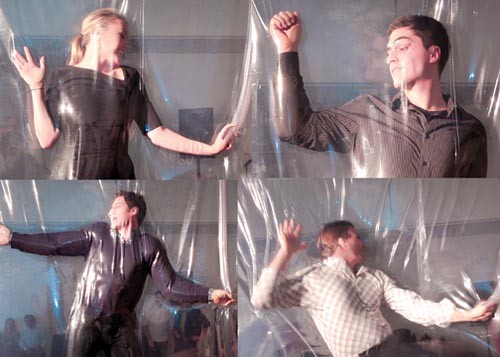Words, memories, flutter like butterflies -- floating just out of reach, haunting about the room. "Easily forgotten moment." "Flashbulb." "Frozen." Each of these fragments of my imagination, each snapshot of the past and its fleeting linguistic representation, fills in another tiny part of the sentence of my life. And yet each one exists separately: I can't grasp them, can't capture them in order, or lasso them with punctuation.
In Arnold Dreyblatt's "Recovery Rotation," a cylinder in a pitch-dark room flashes periodic bursts of light, illuminating for an instant the texts marked around its rotating surface. For a few seconds, pieces of the texts remain on the retina, burned onto the mind's eye. They float before me, tantalizingly close, untouchable. And the words and phrases I can eke out become talismans: "… apparent decay …," "… emotional event …," a simple "and." The paragraphs themselves are of no importance. This universe before my eyes is composed of my own memory: Each word, each fragment, is a myth waiting for my mind to flesh it into story.
Parallel Universe, at Wood Street Galleries, highlights artists such as Dreyblatt, an American artist based in Germany whose work engages with our minds and bodies to compose the experience of another world. These are concurrent universes lying just-buried within our memories, our language, our sense of body and of self.
In "Shrink," Belgian artist Lawrence Malstaf dares viewers to climb between two vertical sheets of industrial-strength clear plastic and be shrink-wrapped by controlling a tube that vacuums the air from the inter-plastic atmosphere. (A second tube is constantly putting air back in, making asphyxiation impossible.) Before climbing inside, the idea struck me with primitive fear -- claustrophobia, dry drowning. Once inside, however, "Shrink" inspires an equally primitive comfort: the womb-like retreat into one's own body, and a complete awareness of that body as an imposition on space.
The displayed video and photographs of Malstaf performing in "Shrink" are problematic: By appearing shirtless and in leather trousers, the Belgian artist perhaps unwittingly implies the fetishistic side that potentially troubles this piece. But the strength of the work lies in removing the sexuality from an experience of the body. It subsists in recognizing completely, if only for a moment, one's bodily self as removed from a modern world that teeters between body-prude and hyper-sexualized, and feeling the self as simply and wholly inhabiting the physical world.
If Malstaf asks us to confront ourselves fully as bodies in "Shrink," his other piece in Parallel Universe -- "Mirror" -- demands that we confront ourselves as selves. Sitting in an easy chair in a small, enclosed room, I push a button and watch the malleable metal mirror covering the wall before me. A machine begins to noisily vibrate the mirror with increasing violence. At first, it appears like a funhouse mirror or a playful iPad app, warping the body and face in ways we've all seen before. Soon, the funhouse mirror gives: Shadows shift to cover the lower half of my face -- it is disappearing, and I am worried. Fear becomes terror when my body and head wail into disintegration: The chair becomes a failing throne, and I'm Francis Bacon's deconstruction of Pope Innocent X.
And then, suddenly, if only for a moment, I'm gone.
There in the mirror is the room, the chair, the button and a howling absence-of-me. That this final state of disintegration lasts but a second before the mirror returns to square one makes "Mirror" no less frightening. Where was I? Did I blink from existence? How can I trust anything if the cornerstone of my subjectivity -- my mirror image -- is so readily compromised?
Like "Recovery Rotation," Austro-French duo Christa Sommerer and Laurent Mignonneau's "Life Writer" toys with a universe that threatens the stability of our language and memory, presenting them as fleeting and untrustworthy, manna for a digital species rather than our rhetorical foundation. A Barton Fink-esque typewriter sits on a wooden table with a dilapidated wooden chair. Glowing "paper" -- an interactive digital screen -- scrolls from the typewriter: Hit the keys and the typebars strike the "paper," printing digital letters. But as you type, animated robotic insects emerge from the paper's edge, seeking the letters, stealing and consuming them. (Glossophages; logovores: We'll call them "term-ites.")
I sat before "Life Writer" typing my name, my phone number, quotes from Burroughs ("When you cut into the present the future leaks out"). In each instance, the term-ites put in a yeoman's effort, jogging to the letters in swarms and feeding. They seem to like vowels -- "O" in particular -- and the most rabid mob I summoned with the carriage was by rapidly repeating "F-O-O-D" and, more vehemently, "L-O-V-E, L-O-V-E …"
PARALLEL UNIVERSE continues through Dec. 31. Wood Street Galleries, 601 Wood St., Downtown. 412-471-5605















